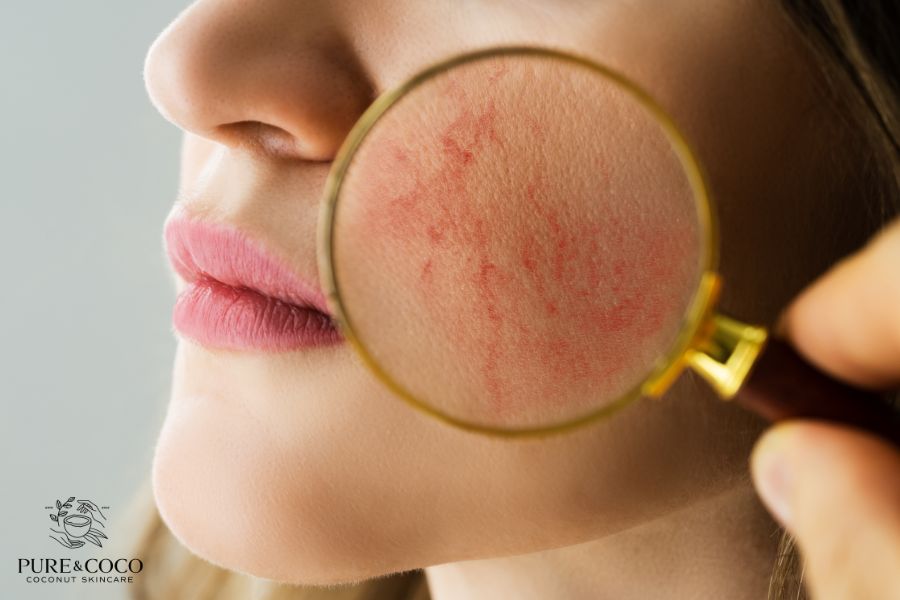Eczema and rosacea are two of the most common chronic skin conditions in the U.S. However, the two disorders are unrelated.
Eczema is probably more common than rosacea, and these conditions can co-exist in some cases. Moreover, both have overlapping symptoms, including itching, bumps, and redness, and can be worsened by some shared triggers.
So, what is the best treatment for rosacea and eczema symptoms naturally so you can feel confident and your best?
Eczema Vs. Rosacea: Know The Difference
Though differentiating between the two can be challenging, some key differences between eczema and rosacea are specific to each. Let’s break down the causes and best treatment for rosacea and eczema symptoms naturally.

Eczema is an inflammatory skin condition that makes the skin sensitive or irritated. As many as 31 million people in America experience eczema. It causes itchy, dry rashes with scaly patches that sometimes can lead to blisters and skin infections. This rash can occur all over the body.
Researchers remain uncertain about the exact causes of eczema. Several factors may combinedly lead to eczema, including genetic mutations, a dysfunctional immune system that causes inflammation, and insufficient production of skin barrier proteins.
Eczema can also be a seasonal skin condition, as people often suffer flare-ups in the fall and winter months (high humidity) when the skin barrier dries out and becomes more sensitive to allergens. In addition, external triggers like dust mites, certain foods, such as fish, peanuts, and rice, high heat, harsh chemicals & soaps, and some. fabrics, such as acrylic and wool, can suddenly worsen the eczema symptoms. Emotional triggers like stress may exacerbate eczema. Conversely, some people may experience eczema flare-ups with no apparent cause.

Rosacea is also a long-term inflammatory condition. According to the American Association of Dermatology, it affects 16 million Americans. The skin barrier is compromised in people with rosacea, resulting in sensitive skin. Burning, flushing, stinging, and itching are common due to the dysfunctional barrier. Common symptoms, usually only on the face or neck, include dryness, redness, raised bumps, superficial dilated blood vessels, thickening skin, and changes in skin pigmentation. Plus, a chronic rash on the central face with a “ruddy appearance.” is a well-known symptom of rosacea. It is also common for rosacea to cause symptoms in and around the eyes.

The exact cause of rosacea is not known yet. Scientists believe it could be due to genetic and environmental factors. Common triggers include skin irritation, sun damage to the skin’s connective tissues, the overabundance of microscopic skin mites (Demodex), emotional stress, and unusual inflammatory response to specific triggers like extreme temperatures, sunlight, wind, spicy foods, alcohol, & exercise. Anything that makes the face flush can cause a rosacea flare, literally.
Treatments & Management
Eczema and rosacea are incurable, and treatments are based on symptom control. A dermatologist can help determine which type of rosacea or eczema you may have and the proper course of treatment.
In addition to prescription treatments, remedies and over-the-counter products help tame outbreaks.

The right skincare remedies and products can help hydrate skin, strengthen, and maintain the integrity of the skin barrier, reduce the symptoms, and calms the inflammations. Eczema or rosacea-friendly skincare should ensure hydration, skin protection, and soothing irritations. Try these Moisturizing Exfoliator and Face & Body Cream by Pure & Coco. A duo enriched with antimicrobial, skin-soothing, and highly hydrating Coconut Oil that help moisturize dry skin, reduce itching, inflammation, and control infection. This is a simple yet complete skincare system that is gentle on fragile, mature skin.
Reference:
- Pathophysiology of atopic dermatitis: Clinical implications (2019)
- Rosacea: Epidemiology, pathogenesis, and treatment (2017)
- Dermatological Conditions in SKIN OF COLOR—: Managing Atopic Dermatitis (2021)
- Dermatology: how to manage rosacea in skin of colour (2022)
Written by: Anujigunasekara for Pure & Coco, LLC | All rights reserved 2022
